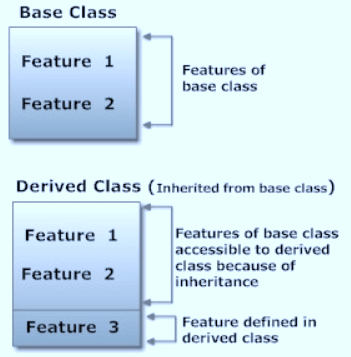python








Python의 OOP 다른 일반 프로그래밍 언어와 동일하게 객체와 클래스를 사용하는 데 중점을 둔 프로그래밍 접근 방식입니다. 개체는 모든 실제 엔터티가 될 수 있습니다. Python을 사용하면 개발자가 코드 재사용성에 중점을 둔 OOP 접근 방식을 사용하여 애플리케이션을 개발할 수 있습니다. Python에서 클래스와 객체를 만드는 것은 매우 쉽습니다.
Python의 클래스는 데이터와 함수의 논리적 그룹입니다. 임의의 콘텐츠를 포함하고 따라서 쉽게 액세스할 수 있는 데이터 구조를 자유롭게 생성할 수 있습니다.
예를 들어 온라인으로 고객 세부 정보를 가져오려는 은행 직원의 경우 customer class로 이동합니다. , 거래 세부 정보, 출금 및 예금 세부 정보, 미결제 부채 등과 같은 모든 속성이 나열됩니다.
이 자습서에서는 다음을 배우게 됩니다.
클래스를 정의하려면 다음 사항을 고려해야 합니다.
1단계) Python에서 클래스는 "클래스" 로 정의됩니다. 키워드
class myClass():
2단계) 클래스 내에서 이 클래스의 일부인 함수 또는 메서드를 정의할 수 있습니다.
def method1 (self): print "Guru99" def method2 (self,someString): print "Software Testing:" + someString
3단계) 함수, 루프, if 문 등의 코드와 마찬가지로 클래스의 모든 항목은 들여쓰기됩니다. 들여쓰기되지 않은 모든 항목은 클래스에 없습니다.

참고 :Python에서 "self" 사용에 대해
4단계) 클래스의 개체를 만들려면
c = myClass()
5단계) 클래스에서 메소드를 호출하려면
c.method1()
c.method2(" Testing is fun") 6단계) 전체 코드는 다음과 같습니다.
# Example file for working with classes
class myClass():
def method1(self):
print("Guru99")
def method2(self,someString):
print("Software Testing:" + someString)
def main():
# exercise the class methods
c = myClass ()
c.method1()
c.method2(" Testing is fun")
if __name__== "__main__":
main() 상속은 객체 지향 프로그래밍에서 사용되는 기능입니다. 기존 클래스를 거의 또는 전혀 수정하지 않고 새 클래스를 정의하는 것을 말합니다. 새 클래스를 파생 클래스라고 합니다. 그리고 상속되는 것을 기본이라고 합니다. . Python은 상속을 지원합니다. 다중 상속도 지원합니다. . 클래스는 하위 클래스 또는 상속 클래스라는 다른 클래스에서 속성 및 동작 메서드를 상속할 수 있습니다.

Python 상속 구문
class DerivedClass(BaseClass):
body_of_derived_class 1단계) 다음 코드 실행
# Example file for working with classes
class myClass():
def method1(self):
print("Guru99")
class childClass(myClass):
#def method1(self):
#myClass.method1(self);
#print ("childClass Method1")
def method2(self):
print("childClass method2")
def main():
# exercise the class methods
c2 = childClass()
c2.method1()
#c2.method2()
if __name__== "__main__":
main() childClass에서 method1은 정의되지 않았지만 부모 myClass에서 파생되었습니다. 출력은 "Guru99"입니다.
2단계) 라인 # 8 및 10의 주석 처리를 제거합니다. 코드를 실행합니다.
이제, 메소드 1이 childClass에 정의되고 출력 "childClass Method1"이 올바르게 표시됩니다.
3단계) 9번 줄의 주석 처리를 제거합니다. 코드 실행
구문을 사용하여 부모 클래스의 메서드를 호출할 수 있습니다.
ParentClassName.MethodName(self)
우리의 경우 myClass.method1(self)를 호출하고 Guru99가 예상대로 인쇄됩니다.
4단계 ) 19행의 주석을 제거합니다. 코드를 실행합니다.
자식 클래스의 메소드 2가 호출되고 예상대로 "childClass method2"가 출력됩니다.
생성자는 객체를 미리 정의된 값으로 인스턴스화하는 클래스 함수입니다.
이중 밑줄(_)로 시작합니다. 그것은 __init__() 메소드
아래 예에서는 생성자를 사용하여 사용자의 이름을 사용하고 있습니다.
class User:
name = ""
def __init__(self, name):
self.name = name
def sayHello(self):
print("Welcome to Guru99, " + self.name)
User1 = User("Alex")
User1.sayHello() 출력은 다음과 같습니다.
Guru99에 오신 것을 환영합니다, Alex
Python 2 예제
위의 코드는 Python 3 예제이며, Python 2에서 실행하려면 다음 코드를 고려하십시오.
# How to define Python classes
# Example file for working with classes
class myClass():
def method1(self):
print "Guru99"
def method2(self,someString):
print "Software Testing:" + someString
def main():
# exercise the class methods
c = myClass ()
c.method1()
c.method2(" Testing is fun")
if __name__== "__main__":
main()
#How Inheritance works
# Example file for working with classes
class myClass():
def method1(self):
print "Guru99"
class childClass(myClass):
#def method1(self):
#myClass.method1(self);
#print "childClass Method1"
def method2(self):
print "childClass method2"
def main():
# exercise the class methods
c2 = childClass()
c2.method1()
#c2.method2()
if __name__== "__main__":
main() "클래스"는 기능과 데이터의 논리적 그룹입니다. Python 클래스는 객체 지향 프로그래밍의 모든 표준 기능을 제공합니다.
python
파이썬 프로그래밍 언어를 사용하면 멀티프로세싱 또는 멀티스레딩을 사용할 수 있습니다. 이 자습서에서는 Python에서 다중 스레드 응용 프로그램을 작성하는 방법을 배웁니다. 스레드란 무엇입니까? 스레드는 동시 프로그래밍에서 실행 단위입니다. 멀티스레딩은 CPU가 한 프로세스의 많은 작업을 동시에 실행할 수 있도록 하는 기술입니다. 이러한 스레드는 프로세스 리소스를 공유하면서 개별적으로 실행할 수 있습니다. 프로세스란 무엇입니까? 프로세스는 기본적으로 실행 중인 프로그램입니다. 브라우저나 텍스트 편집기와 같은 컴퓨터에서 응용 프로
Python Attrs 패키지를 사용하면 간단한 주석을 사용하여 고급 데이터 클래스를 만들 수 있습니다. 물론 python에는 고유한 기본 데이터 클래스 모듈도 있지만 Python attrs 패키지는 여러분이 좋아할 만한 몇 가지 추가 기능을 제공합니다! 목차 속성 설치 속성 대 데이터 클래스 기본 Python 속성 예제 Python 속성 유효성 검사기 예 Python 속성 변환기 예 Python 속성과 함께 슬롯 사용 계속 학습 설치 속성 attrs 패키지는 기본 라이브러리의 일부가 아니므로 pip install 명령 또